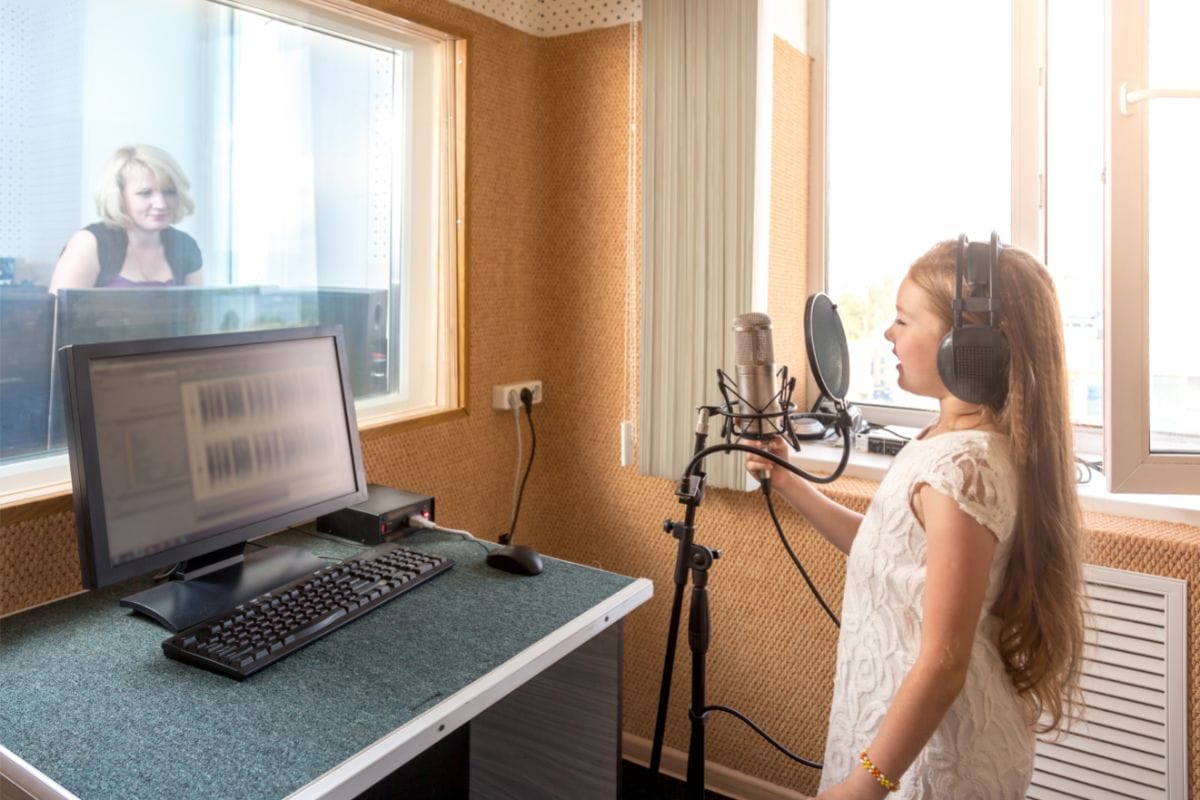If you plan on using someone else’s songs in your original material or a particular recording, whether that is a film or advertisement, or other similar media, having proper permission matters to follow copyright law and sound legal advice from a lawyer. Permission to use a song is an important step to worry-free expression and creation, be it one song or many.

You will need to purchase an appropriate license to play the song. In this article, we will be discussing everything you need to know about how much it costs to license a song.
What Are The Different Types Of Music Licenses?
The first thing you need to know about permission for music for TV, film, or advertising is that there are different types of licenses available. Whether for private or commercial use, there are specific permissions that allow the use of musical work and original music. The permissions cost differently, provide different usage rights, and can vary from indy productions to the ability to license famous songs.
Synchronization (Sync) Licenses
The most common license used today is called a synchronization license. This allows you to use permitted music in your project without having to pay royalties for each individual performance. A synchronization license is typically used in film, television, video games, and other multimedia projects to allow the use of copyrighted music.
A synchronization license grants you the right to synchronize a piece of music with visual media, such as a movie or video game. It also allows you to alter the song by adding additional instruments or voices or changing the music’s tempo or pitch. However, it does not allow you to make copies of the original work for sale or distribution.
These licenses can cost between a few hundred dollars for a small independent production to tens or even hundreds of thousands of dollars for a major film or television project. Additional costs can also stem from administrative fees or costs associated with the licensing process through agencies or organizations.
You can also use this license if you want to create a commercial with licensed music but don’t want to have to pay the copyright holder any money.
All Rights Reserved License
Another license type is called “all rights reserved,” which means that the copyright owner has retained all rights and will not allow you to perform their song unless they receive compensation. An all rights reserved license for music is a type of copyright that prevents the licensee from using or distributing material without permission from the copyright holder.
This means that the licensee cannot reproduce, publish, or modify the music in any way without express written permission from the copyright owner. Additionally, if someone else wants to use or distribute the music, they must also obtain permission from the copyright holder. All rights reserved licenses provide extensive protection to artists and composers who want to maintain control over their intellectual property.
Costs of obtaining an all-rights reserved license come from the popularity of the music, intended use of the music, bargaining power of the parties involved, length of license, territory or geography, and restrictions on how the music can be used.
If you choose this option, then you must obtain permission from the holder who owns the copyright, before you can use the song.
Non-Exclusive License
The third type of license is called a “non-exclusive” license. This means that the copyright holder has granted you certain non-exclusive rights to use the song. These include the right to reproduce, distribute, display, and perform the work publicly. A non-exclusive license for music is a type of agreement that grants the licensee permission to use a piece of music without granting them exclusive rights to use it.
This means that the licensor can still grant other people the same rights to use the music and doesn’t have to give them exclusive access. The licensee typically pays the licensor a fee for the music rights in their project, which may include films, television shows, advertisements, and more. Non-exclusive licenses are popular because they are typically much less expensive than exclusive licenses and allow multiple people to use a particular song in different projects at once.
Generally, these licenses cost less than an all rights reserved or exclusive permit, based on a fee for a one-time payment or recurring fee made through terms negotiated between the licensor and licensee. Costs also come from the popularity and commercial value of the music, as well as the length and extent of usage.
Master Recording License
You may also wish to consider purchasing a master recording license. This allows you full access to the track so that you can make edits to the sound file. Master recordings are usually only available through record labels. A master recording is a document that grants a third party the right to use a master recording of a song or other audio material in some way (for radio play, television broadcast, advertising, etc.), including background music.
This typically covers both public performance and mechanical licenses for reproduction rights. It should include information about the licensor (the owner of the copyright in the master recording) and licensee (the person or company requesting permission to use the recording), as well as any terms and conditions associated with the usage of the master recording.
Similar to other licenses, a series of factors come into play in determining the cost of getting a master recording permit, including the popularity and commercial value of the recording, length, and extent of the usage, and fees that come from any agencies or organizations (record company or major music publishers) that charge administrative or licensing process fees.
Public Communication License (PCL)
The Public Communication License for music is a royalty-free system that allows musicians to share their music without having to pay royalties or licensing fees. It is an alternative to traditional copyright, where the artist holds all rights and must be compensated for their work. The PCL requires that the artist grants permission to anyone who wishes to use their music in public performances, broadcasts, and other forms of media.
This means that the artist will receive no royalties or compensation unless they actively opt in or negotiate a separate contract. The PCL also provides artists with more control over how their music is used by allowing them to set certain parameters such as geographic restrictions, commercial usage restrictions, and more. Artists can also choose whether they want to charge a fee for using their work or make it freely available for anyone to use. By using the PCL, musicians are able to share their music while still retaining control of its usage.
The PCL costs are typically determined on a percentage basis from an establishment’s gross revenue or a flat annual fee, depending on negotiations and terms negotiated by the licensee and owner or licensing organization. The percentage fee may also be determined based on the location and size of the establishment and the type of music being played. Permission can be expensive and complex, but often times parties are willing to get into negotiable terms.
Reproduction License
The reproduction License for music allows a legal entity to reproduce, distribute, and make available the musical works of an owner or songwriter. This type of document is necessary in order for any commercially released music to be legally distributed. With this, the copyright holder grants permission to use their work in exchange for payment or other compensation, including the development of cover songs.
The reproduction license will typically outline the terms and conditions of usage, such as how many copies can be made, what rights are granted, and what royalties need to be paid. It also covers the rights of the user in terms of using the material (like music tracks) as well as restrictions on where and how it can be used. This is key in protecting both the copyright holder’s rights and those of the user.
Reproduction licenses tend to be charged through a negotiated rate between the licensee and the copyright owner or organization. factors for pricing tend to be the length of reproduction, media format, and any exclusivity or territorial/geographical restrictions.
In some cases, a blanket license can cover the reproduction and distribution of a large catalog of music with thousands of songs for a specific type of industry by a licensing organization (like a BMI license issuance) instead of permission for only per song. These blanket documents can often simplify the process and provide cost savings and an affordable way for a licensee to secure rights.
Distribution License
The distribution license for music is a type of agreement that grants permission to the licensee to distribute or reproduce the music. This license often involves some form of royalty payment or fee, which is paid to the copyright holder in exchange for the right to distribute their work. It may also include restrictions on how the licensee can use and modify the original material, as well as any other terms and conditions agreed upon by both parties.
Generally, distribution licenses are used by companies that wish to create commercial products using copyrighted material, such as physical formats like CDs or digital downloads for sound recordings. In addition, it can be used by artists who wish to allow others to share their work without making them pay royalties each time it’s used. Distribution permission is an important part of copyright protection and must be carefully followed when distributing any type of music.
The cost of obtaining licenses like this can be influenced by factors like the media format, length of distribution, exclusivity clauses, territorial/geographical restrictions, or other provisions. Similar to the reproduction type of protection, there may also be blanket coverage determined by a licensing organization or agency – to offer a straightforward process for licensees.
Print Rights License
The Print Rights License for music is a license that gives the user permission to make physical copies of musical works. This license is typically used when someone wants to create sheet music, books, or other printed materials from a musical work. It can also be used to make digital recordings of musical works for distribution.
It is important to note that this license does not give the user the right to record and distribute copyrighted material without permission from the copyright holder. The Print Rights permit allows users to make physical copies as long as they abide by all laws and regulations regarding such activities. These also require users to include proper attribution to rights holders when distributing any materials created.
Similarly, the print rights license acquisition costs are based on a myriad of factors. The cost can be affected by the specific music being printed, the intended use, the bargaining power of the parties involved, the length of the run, the number of copies printed, and exclusivity or geographical terms.
Ultimately, the Print Rights License ensures that creators are properly compensated for their work while allowing others to enjoy it in various formats.
Theatrical License
Theatrical Licenses for music allow the holder to use musical works in a theatrical production. This gives permission to the holder to use music, songs, and other musical works in their theatrical performance. This permission also allows the holder to make a recording of their performance and distribute it to others.
The license also covers any potential copyright issues that may arise from using copyrighted material in the performance. These can be obtained from a performing rights organization or publisher, and they will usually require payment of a fee or royalties in exchange for the rights granted. It is important to remember that if you plan on using copyrighted material in your performance, you need to obtain the appropriate licensing before doing so.
Costs tend to be determined by the length of the production run, number of performances, exclusivity, geographical restrictions, duration, and size of the production, for example.
When Should I Buy A License?
If you are planning on creating a commercial or television show, then you should definitely get a synchronization license. However, if you are just making a short film or video clip, then you do not need to worry about buying a synchronization license. Now that you know what you’re able to get for the music you want, you’ll likely need to pay for popular music to legally use them.
While there are many free songs with royalty-free licenses available, the benefits of music that come from premium music sources may suit your needs better and faster. Well-known artists’, heck, all artists work hard to provide great music and a song that might stir the right feeling.
If you are going to be performing a song live, then you should always contact the copyright holder to find out what kind of license they require.
How Much Does It Cost To License A Song?

Many factors go into determining how much it costs to buy a license, it can vary widely. The price depends on several things, including:
- The length of time you intend to use the song.
- The length of the song.
- How many times you plan on playing the song.
- Whether you plan on selling copies of the song.
- The average rate at which people pay for these permissions.
The average cost per usage varies depending on the type of usage. For example, a single usage of a song would typically be less than $100. However, if you plan on performing the song more than once, then you could end up paying hundreds of dollars for single usage.
While costs can vary wildly (especially when not offered in a blanket license or through an agency or organization), here are some average costs by type (reference):
- Synchronization permissions can cost between $0.25 per copy with a minimum amount of $25, and up to $100,000 (reference).
- Non-exclusive permissions can run between $20-99 (reference).
- A master recording permission can cost between $100 for an independent artist to several thousand dollars, plus fees for a major recording artist/label (reference).
- Public communication permissions can cost between $300-500 for a small business to as much as $9,000 per location per year (reference).
- Reproduction permissions can cost between $50-150 for small independent artists to $500-5000 or more for famous songs or famous music (reference).
- Distribution permission can cost between 5-10% of the retail price or 15-20% of the wholesale price (reference).
- Print rights permissions can cost between 12.5% to 20% of the retail costs for the music as a royalty (reference).
- Theatrical rights permissions can cost between $50 and $250 per performance (reference).
Can I Use My Own Song Instead Of Licensed Music?
Yes! There are two ways you can approach this problem. First, you can hire a professional musician to write a new version of the song.
Second, you can ask a friend who plays guitar to play along with your song using his/her own instrument.
How Do I Get Started With Music Licensing?
Before you start licensing songs, you should first determine whether you want to purchase a synchronization or an all-rights reserved license. Most professionals recommend starting with synchronization permission because it’s easier to manage. Once you’ve decided on the type you want, you’ll have to decide what kind of license you’re looking for. You can either purchase a sync or a master recording license.
Synchronization permits are generally used by companies who want to create commercials or TV shows. They give you the right to synchronize the song in your project. Master Recordings are mostly used by individuals or small businesses who want to make edits to the sound files. They give you the ability to record the song yourself. Once you know what kind of permission you want, it’s time to find out how much it will cost.
The next step is to contact the copyright holders of each song you want to use. If you don’t already have their email addresses, you can search online for them. Once you’ve contacted the copyright holders, you can negotiate a deal with them. Negotiating a deal means that you and the copyright holder come to an agreement regarding the price and terms.
If you choose to work with a professional publisher, you may also want to consider hiring a composer or lyricist to help you write a new version of your song. This way, you won’t have to spend as much money on licensing fees. When you have reached an agreement with the copyright holder, you can send him/her a check. After receiving the payment, the copyright holder will issue you permission.
What Are Some Common Uses Of Songs?
Music has been around since ancient times. In fact, most cultures have had some form of musical tradition.
Today, we still see music being used in movies, television, video games, advertisements, and other forms of media. Below are just a few examples of how songs are commonly used.
Music For Advertising
Advertising agencies often use songs to promote products. One example would be when Mcdonald’s makes use of a song like “Gangnam Style” to advertise its Happy Meals.
Television Shows
Television shows typically use songs to set the mood of the show. For instance, the theme song from Friends was written by David Foster.
Movies
Many movie trailers feature popular songs. For example, the trailer for the film “Titanic” featured the song “My Heart Will Go On”.
Video Games
A lot of video games use licensed songs to enhance the game experience. For instance, the song “I’m Your Man” was used in the game “Grand Theft Auto V”.
How Do I Know How Many Times Someone Else Has Licensed My Song?
You can easily determine this information if you’re willing to do a little research. You’ll need to contact the copyright holders for each song you want to license. Once you’ve done so, you can look up the number of times someone else has used the same song.
You can find this information online. Just enter the name of the song into Google and then click on the first link that appears. If you don’t know the name of the song, you can simply search for the lyrics.
How Do I Get Permission To Use Someone’s Song?
Before you begin working on any project, make sure you get permission from the copyright holder. There are two ways to do this. First, you can ask the copyright holder directly. Second, you can hire a professional music publisher who specializes in obtaining permissions for artists.
If you decide to work with a professional publisher, you should ask them about their rates. They should be able to give you a ballpark figure based on the type of project you’re planning on doing. If you decide to work with an individual instead, you should be prepared to negotiate.
The copyright holder may offer a flat fee for licensing his/her song. Or, he/she might require you to pay royalties on every copy sold.
Conclusion
In conclusion, the cost to license a song, whether it’s an easy song to reproduce or a complex melody, depends on a variety of factors that can drive the price up to hundreds of thousands of dollars for a single use if the song is incredibly popular. Whatever you decide to do, it’s important to make sure that you put in the research to ensure that the license remains within your budget.
- Can We Use Envato Elements On Youtube Videos - July 15, 2022
- What’s The Highest Quality Image Format? - July 15, 2022
- Pexels Reviews: Is Pexels Legit? - July 15, 2022








